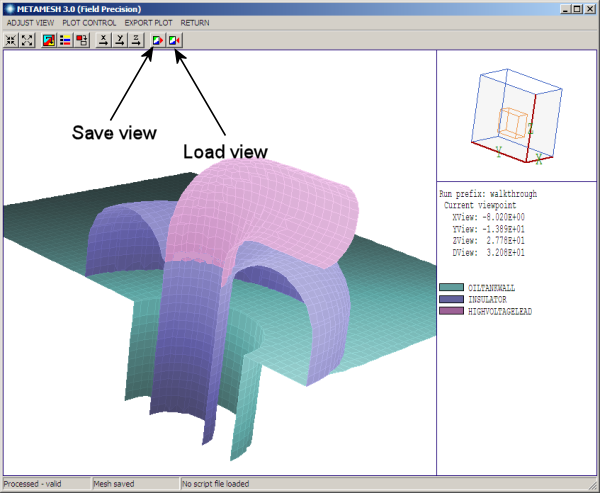Plotting is critical to understand meshes and field solutions in three-dimensional spaces. In consequence, we have included a wide variety of options for creating plots in MetaMesh and the analysis programs PhiView, MagView, HWV, RFE3View and Aerial. For example, the following information is neede to create a 3D view of a mesh:
- Parameters of the point of view, such as the origin of the view axes, the position of the viewpoint in rotational space and the distance from the assembly. These quantities affect the centering of objects, visible surfaces and the perspective.
- Choice of regions or parts to display.
- Cut planes to reveal inner details.
- Reference axes with automatic or user-specified grids and ticks.
Users can expend significant effort to create an optimal display. Therefore, the ability to record to to restore one of more specific views of an assembly saves time and provides documentation.

Figure 1. Tools for saved views, AMaze programs.
We have added saved views to MetaMesh and other AMaze plotting programs. Figure 1 shows new tools that appear in all plotting menus. They function for both 3D plots (as shown) or 2D slice plots. The Save view command generates a formatted text file FPrefix.FPV where FPrefix is a descriptive name. The file contains the complete set of plotting parameters. This excerpt illustrates the format:
Program: MetaMesh
2D/3D: 2D
DisplayBy: Regions
Outline: On
NSlice: 40
SliceAxis: YAxis
PlotType: LogElemUp
XPMin: -1.500000E+00
XPMax: 4.250000E+00
...
The ability to restore an exact plot when a specific solution has been loaded is useful but not particularly original or interesting. Saved views in the AMaze programs transcend the standard in two ways:
- Dynamic adaptation to different solutions.
- Option for user control of the view parameter set.
Regarding the first feature, there are situations where the user wants to create consistent views of a set of solutions with different geometries, maintaining a similar appearance. Some plot properties (like the viewpoint rotation matrix) are applicable to any solution, but others (like region cutplanes or slice plot limits) depend on the geometry. In AMaze, the load process is adaptive. The programs check each plot parameter for validity. If a parameter is outside the allowed range for the currently-loaded solution, the program computes an alternative. The goal is to preserve as many features of the view as possible.
The second unique feature is that users can modify view files. The order of entries is not rigid. On input, the program uses a free-form parser. If a parameter is missing, the program simply makes no change from the current value in the program. The implication is that a user can edit a view to include only elements essential to his application. For example, one could compare a series of assemblies with different sizes, maintaining an orthographic 3D view from the same point in Cartesian space. In this case, the view file would contain only the entries:
DView: 1.000000E+37
R11: 8.660253E-01
R12: -5.000002E-01
R13: 0.000000E+00
R21: 1.669031E-01
R22: 2.890846E-01
R23: 9.426408E-01
R31: -4.713208E-01
R32: -8.163510E-01
R33: 3.338061E-01
LINKS